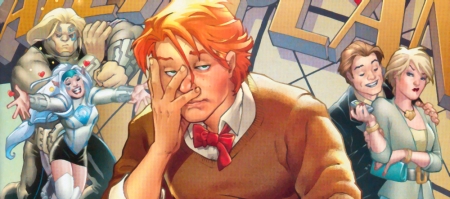A few years ago, I started trying to dress like a grown-up. I'd always had an interest in the accoutrements of traditional masculinity--in things I saw men wearing in old movies, in felt hats and sleeve garters and suspenders--but I'd always felt constrained by budget and lack of knowledge and the relentless casualness of contemporary life in North America. However, I was starting to teach classes at the university and had to think more about how I was presenting myself to a lecture theatre full of students who were less than a decade younger than myself. So, I started wearing ties and jackets and making no excuses for it.* I don't pretend to be an expert on men's style or to be the best dressed dude on the block, but, y'know, I try.
More recently, I've gotten back into reading popular comic books after some absence from the genre(s). In practice, this means a lot of DCU superhero books.† One thing that I've noticed since coming back to them is how badly a lot of the men in comics are dressed. I'm not talking about superhero costumes; I'm talking about guys like Bruce Wayne and Jimmy Olsen.
Now, I try not to be (too) judgmental about these things. But there are some instances where their poor fashion choices break character and start to undermine my willing suspension of disbelief. It's like Alex Toth says in his famous critique of some Steve Rude Jonny Quest pages, "The fakery's so obvious […] that it detracts from what follows—you cripple credibility at the start (yours! and the story's!)[….]"
For instance, let's look at a recent issue of writer Grant Morrison's Batman, Inc. with art by Yanick Paquette [p], Pere Perez [p; pp. 16–17], and Michel Lacombe [i]. For those of you just joining us, Batman is "franchising," recruiting heroes around the world to join a new initiative (publicly bankrolled by Wayne Enterprises) to build capacity for some shadowing danger looming on the horizon. In this issue, #4, he travels to Argentina to meet with El Gaucho, an original member of the Batmen of All Nations. Following a scene where they together escape exploding scorpions in a hot air balloon, we join Batman incognito at the villa of Don Santiago Vargas (the Gaucho's alter ego)…
Paquette's drawn Bruce Wayne, international billionaire playboy and the man whose picture is next to "suave" in the dictionary, in a gigantic, baggy suit that can't seem to decide if it has three buttons or two. However many buttons there are, he is resolute about buttoning all of them.
I'm sorry, but that's not Bruce Wayne. These are Bruce Wayne:‡
Or, how about this week's Jimmy Olsen one-shot? Written by Nick Spencer and pencilled by R.B. Silva (with some fill-ins towards the end by Amilcar Pinna), these stories were originally scheduled as back-up features in Action Comics, but their space was sacrificed by the Powers That Be at DC in order that they might "draw the line at $2.99," and so they were collected together and issued as an 80-page giant. The stories are smart and funny and have pretty much everything that I like about the genre (see Chris Sims's review on ComicsAlliance). One clever thing that Spencer does is expand the world of the modern-age Jimmy, giving Superman's pal a kind of parallel supporting cast. Where Superman/Clark has Lois Lane, Girl Reporter as romantic interest and professional rival, Spencer's brought in a character that originally debuted on the Smallville TV series, Chloe Sullivan (mirroring Jimmy's own origins on the Superman radio show). And where Superman/Clark has Lex Luthor as his nemesis, Jimmy has Sebastien Mallory, who he describes as "the Biff to my Marty, the Leno to my Conan, the parents to my just don't understand." Here's Sebastien out for a night on the town…
Again, fit is a tremendous problem. This isn't a suit: It's a tent. And where Paquette's Bruce Wayne had a button vanish on him, Silva's Mallory apparently has no need for such contrivances. "Buttons? What are these 'buttons' you speak of?" The plunging neckline on his sweater is a little out of control, and I'm not sure Silva understands how either lapels or neckties look. I mean, look again at that knot.
I just can't believe that "Lexcorp's Bright Young Star" would dress like this. I mean, Lexcorp is all about arrogance and vanity and using slickness to keep the public from realizing that its executives are villainous scumbags.
(Jimmy himself generally looks pretty good. Though, I can't help questioning the wisdom of including jokes about his bowtie when bowties haven't been cooler in, well, ever?)
Anyway. Why am I harping on the fact that a couple of comic artists have "faked" the clothes they've dressed their characters in? To be fair, one hard thing about this medium is that the artist(s) have to do the (narrative) work of an entire film crew: they choose the angles and direct the "actors," of course, but they also design the locations and props and, yes, the costumes. That's a lot to do for a monthly comic, and so sometimes mistakes will be made. No real harm, no real foul.
But I think this goes a little deeper. I don't know anything about these artists as individual people, but I think these lapses point to something a little deeper.
In a paper on the geeky t-shirt industry that has colonized the web in the last ten years, Jason Tocci writes, "Several of my interviewees indicated that geeks do not have a reputation for being stylish, and that they tend to dress pretty casually" (7). This probably comes as no surprise to anyone. The geek "uniform" is a t-shirt, preferably black, screenprinted with a graphic or slogan than makes a reference to a beloved media text or an in-joke related to nerd culture. Thus, the content of the clothing, its message, is more important than its appearance as such: Even when it comes to their wardrobe, nerds favour substance over style.
Moreover, in our culture more generally, fashion, style, and dress are not things that occupy most men, and especially not middle or working class men. It's not a hard and fast rule, but there is some normative force behind it. (Think of all the sitcom episodes that rely on it.) No, caring about clothes is for wealthy dilettantes or gay men or wealthy dilettantes who are suspected of being gay.
When you combine the lack of concern for clothing that most men are socialized to have with nerds' general dismissal of appearance and style and the fact that most comic artists initially learn to draw copying the superhero comics they themselves grow up on (a genre where most "clothing" behaves more like bodypaint), then you have a recipe for consistently faked costuming decisions.
I don't think everyone has to dress the way I like to and the way I think looks good. The point isn't that Bruce Wayne or Sebastien Mallory dress poorly. Its that these particular characters ought to be sharp-dressed men, and it's only that their artists have dressed them poorly. Contrast the Jimmy Olsen interior art with Amanda Conner's cover illustration:
Not only has Conner clearly looked at a bowtie once or twice in her life, but she's put Mallory in a dark business suit (note the peaked lapels) that tells me he dresses to be taken seriously, an act of impression management that she's undercut using facial expression and body language.
Like the rest of the Lexcorp bunch, he's little more than a skeezeball covered by a thin veneer of public relations.
He's the kind of guy who would try to destroy net neutrality as part of a sinister plot to take over the world.
He's the kind of guy who will take every opportunity to insult our hero while putting the moves on his (ex-)girlfriend.
He's a character who's ready to be shown to a reader.
*It didn't hurt that this was around the same time that the hipsterati were getting into Mad Men and jumping onto the mid-century bandwagon.
†I've also been enjoying IDW's Doctor Who and Dungeons & Dragons series, Image's Chew, and the Roberson/Allred Vertigo book, iZombie. But it's by and large the DC superheroes that I cared about when I was 14 that are making it into my weekly haul.
‡I guess I'm showing my prejudice for the interpretation of the character where Bruce is not a bumbling decoy to avert suspicion a la a certain mild-mannered reporter we all know and love. There is a decidedly Brooks Brothers version of Bruce in the original seasons of Batman: The Animated Series, and that can work, too, but I really feel like Morrison is trying to give us a more Hugo-Boss Bruce Wayne.




